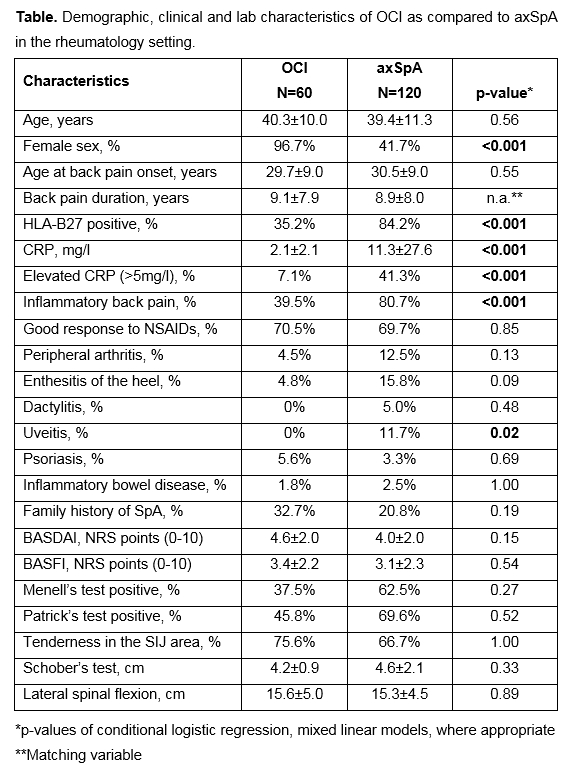Session Information
Date: Monday, November 6, 2017
Title: Spondyloarthropathies and Psoriatic Arthritis – Clinical Aspects and Treatment Poster II
Session Type: ACR Poster Session B
Session Time: 9:00AM-11:00AM
Background/Purpose:
Osteitis condensans ilii (OCI) is regarded as a non-inflammatory disorder, which is considered to be induced by mechanical stress (e.g., by pregnancy and delivery). An extended sclerosis of the sacroiliac joints without erosions or ankyloses is the most characteristic imaging feature. More recently, paraarticular bone marrow edema has been described on magnetic resonance imaging, which can occur early but also intermittently later in the course of the disease. The clinical characteristics of OCI patients have not been well described. To date, there are no published systematic data on the characteristics of OCI as compared to axial spondyloarthritis (axSpA).
The objective of this matched case-control study was to investigate demographic, clinical, and lab characteristics of OCI as compared to axSpA.
Methods:
Using medical database search we have identified n=103 patients aged ≥18 years who were diagnosed with OCI upon presentation with chronic back pain in the Early Spondyloarthritis Clinic of the rheumatology department in the Charité University Hospital between January 2010 and May 2015. These patients were contacted in order to obtain an informed consent and to complete a survey on the disease-related history. N=60 OCI patients who provided an informed consent and completed the survey were included in the final analysis. These patients were matched with a 1:2 ratio according to the back pain duration to patients with definite axSpA diagnosed in the same setting in order to compare demographic, clinical and lab characteristics.
Results:
The main characteristics of the two groups are presented in the table. Most importantly, all but 2 patients with OCI were females and had a significantly lower prevalence of inflammatory back pain, lower level of CRP stressing a rather non-inflammatory nature of this condition. All patients were referred because of possible axSpA, therefore SpA features, although being lower than in axSpA patients (table), were higher than can generally be expected in chronic back pain patients. This is probably the reason why a statistical significance in comparison to axSpA was observed for uveitis only. There was no difference in age of back pain onset. Signs of sacroiliitis at physical examination were only slightly more frequent in axSpA; there were no differences in spinal mobility. The level of symptoms (BASDAI) and the perceived level of functional disability (BASFI) were comparable between groups. 83% of female patients with OCI reported a history of at least one pregnancy with a mean number of pregnancies of 3 (median=3, range 1-8).
Conclusion:
OCI manifesting with chronic back pain starting before 45 years of age represents an important differential diagnosis for axSpA. A constellation of a female sex (with a history of pregnancies), negative HLA-B27 and negative CRP seems to be of differential diagnostic value as compared to axSpA.
To cite this abstract in AMA style:
Weineck H, Listing J, Diekhoff T, Hermann KG, Sieper J, Poddubnyy D. Similarities and Differences between Osteitis Condensans Ilii and Axial Spondyloarthritis Patients Presenting with Chronic Back Pain in a Rheumatology Setting [abstract]. Arthritis Rheumatol. 2017; 69 (suppl 10). https://acrabstracts.org/abstract/similarities-and-differences-between-osteitis-condensans-ilii-and-axial-spondyloarthritis-patients-presenting-with-chronic-back-pain-in-a-rheumatology-setting/. Accessed .« Back to 2017 ACR/ARHP Annual Meeting
ACR Meeting Abstracts - https://acrabstracts.org/abstract/similarities-and-differences-between-osteitis-condensans-ilii-and-axial-spondyloarthritis-patients-presenting-with-chronic-back-pain-in-a-rheumatology-setting/

